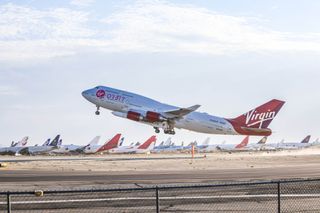
Update for 5 pm ET on July 1: Virgin Orbit announced today (July 1) that it's planning to launch the "Straight Up" mission early Saturday morning (July 2). A launch webcast will begin at 1:20 a.m. EDT (0520 GMT), "with the launch soon to follow," company representatives said in an emailed statement.
Virgin Orbit will launch its fourth commercial satellite mission early Thursday morning (June 30), and you can watch the action live.
The California-based company employs an air-launch system, sending a two-stage rocket called LauncherOne aloft beneath the wing of a plane known as Cosmic Girl. The carrier plane is scheduled to lift off from Mojave Air and Space Port in California Thursday during a window that opens at 1 a.m. EDT (0500 GMT; 10 p.m. local California time on June 29).
Cosmic Girl will head west and then southwest, eventually reaching a drop zone west of the Channel Islands off the California coast. The plane will then deploy the 70-foot-long (21 meters) LauncherOne, which will light up and power its way to orbit. You can watch it all here at Space.com, courtesy of Virgin Orbit, or directly via the company; coverage will begin at 12:45 a.m. EDT (0445 GMT).
In photos: Virgin Orbit's LauncherOne rocket for satellite missions
Virgin Orbit, part of Richard Branson's Virgin Group of companies, has three successful satellite-launching missions under its belt. Those three all occurred in a row, in January 2021, June 2021 and January 2022. They came after the company's only launch failure, a May 2020 test flight that marked the debut of LauncherOne.
The rocket is carrying seven payloads on Thursday for the U.S. Department of Defense’s Space Test Program.
Get the Space.com Newsletter
Breaking space news, the latest updates on rocket launches, skywatching events and more!
"The payloads are designed to conduct experiments in space-based communications and to demonstrate novel modular satellite bus, space domain awareness and adaptive radio frequency technologies," Virgin Orbit representatives wrote in an emailed description.
The satellites will be deployed at an altitude of 310 miles (500 kilometers), if all goes according to plan.
Virgin Orbit calls Thursday's mission "Straight Up," after the breakthrough hit off Paula Abdul's 1988 album "Forever Your Girl." That album was released by Virgin Records, another member of the Virgin Group. (The space tourism company Virgin Galactic is in the family as well.)
The previous two Virgin Orbit missions got this musical treatment as well. The June 2021 flight was called "Tubular Bells Part 1" after the first track off Mike Oldfield's 1973 album "Tubular Bells," the first record that Virgin ever released. And the January 2022 mission was named "Above the Clouds," after a song by Gang Starr. "Above the Clouds" is from the 1998 album "Moment of Truth," also a Virgin release.
Mike Wall is the author of "Out There" (Grand Central Publishing, 2018; illustrated by Karl Tate), a book about the search for alien life. Follow him on Twitter @michaeldwall. Follow us on Twitter @Spacedotcom or on Facebook.
Join our Space Forums to keep talking space on the latest missions, night sky and more! And if you have a news tip, correction or comment, let us know at: community@space.com.

Michael Wall is a Senior Space Writer with Space.com and joined the team in 2010. He primarily covers exoplanets, spaceflight and military space, but has been known to dabble in the space art beat. His book about the search for alien life, "Out There," was published on Nov. 13, 2018. Before becoming a science writer, Michael worked as a herpetologist and wildlife biologist. He has a Ph.D. in evolutionary biology from the University of Sydney, Australia, a bachelor's degree from the University of Arizona, and a graduate certificate in science writing from the University of California, Santa Cruz. To find out what his latest project is, you can follow Michael on Twitter.
